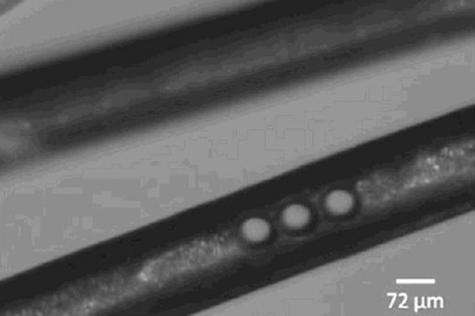April 29, 2011 report
New forensic laser technique for hair analysis can reveal historical data

(PhysOrg.com) -- Using a new laser technique, Jim Moran and his colleagues at Pacific Northwest National Laboratory, have devised a method of separating out the parts of hair samples that can reveal details about the recent history of the person to whom it belongs.
In their paper, published in Rapid Communications in Mass Spectrometry, they describe a process they’ve devised whereby hair samples are pulled apart, rather than burned as a whole before being measured by a mass spectrometer. Such a process could be used to reveal personal details about someone, such as what they eaten recently; clues that might provide forensic scientists insight into the behavior of victims of foul play for example, or reveal information as the whereabouts of the accused during the time frame surrounding a crime.
Because traditional laser analysis techniques tended to obliterate entire samples as they burned all of its parts together as a whole (leaving their gases to be released and measured in a spectrometer) Moran and his team chose to use a less destructive type of laser that uses only ultraviolet light (similar to the kind used for LASIK eye corrective surgery). They discovered that by doing so they could essentially break apart the individual pieces and parts of the hair as a hole was bored, which could then be burned separately and tested with the spectrometer; sort of like burning the filings left over when drilling into a piece of wood with an iron bit. Because hair grows slowly over time, it creates a timeline of sorts, with different stages representing differing days, weeks or even months The new technique allows for dozens of such holes up to be burned up and down the length of a single strand of hair, retrieving different samples that represent different points in time. Then, by studying the different stages of that timeline, analysts are able to piece together a historical picture of what someone has been eating during different times in the past.
Currently the technique only looks at carbon isotopes released when hair is burned, which is how a historical diet is put together; subsequent experiments however will look at oxygen and nitrogen isotopes as well, to get a better picture of water, sulfur and other mineral intakes which could help identify other environmental circumstances prior to the sample being taken.
More information: Laser ablation isotope ratio mass spectrometry for enhanced sensitivity and spatial resolution in stable isotope analysis, James J. Moran, Matt K. Newburn, M. Lizabeth Alexander, Robert L. Sams, James F. Kelly, Helen W. Kreuzer, Rapid Communications in Mass Spectrometry, Article first published online: 12 APR 2011 DOI:10.1002/rcm.4985
DOI: 10.1002/rcm.4985
Abstract
Stable isotope analysis permits the tracking of physical, chemical, and biological reactions and source materials at a wide variety of spatial scales. We present a laser ablation isotope ratio mass spectrometry (LA-IRMS) method that enables δ13C measurement of solid samples at 50 µm spatial resolution. The method does not require sample pre-treatment to physically separate spatial zones. We use laser ablation of solid samples followed by quantitative combustion of the ablated particulates to convert sample carbon into CO2. Cryofocusing of the resulting CO2 coupled with modulation in the carrier flow rate permits coherent peak introduction into an isotope ratio mass spectrometer, with only 65 ng carbon required per measurement. We conclusively demonstrate that the measured CO2 is produced by combustion of laser-ablated aerosols from the sample surface. We measured δ13C for a series of solid compounds using laser ablation and traditional solid sample analysis techniques. Both techniques produced consistent isotopic results but the laser ablation method required over two orders of magnitude less sample. We demonstrated that LA-IRMS sensitivity coupled with its 50 µm spatial resolution could be used to measure δ13C values along a length of hair, making multiple sample measurements over distances corresponding to a single day's growth. This method will be highly valuable in cases where the δ13C analysis of small samples over prescribed spatial distances is required. Suitable applications include forensic analysis of hair samples, investigations of tightly woven microbial systems, and cases of surface analysis where there is a sharp delineation between different components of a sample.
© 2010 PhysOrg.com

















